| A (8) | 1M right hand turn 2W, and cast to 2M place (2M moving up) (4) 1W right hand turn 2M (now opposite, not on the corner) and cast to 2W place (2W moving up) (4) |
| B (12) | Lines fall back 3 steps and advance 3 steps, looking at your partner (2) Turn single towards your neighbour (2) 1C full figure of 8 up through 2C using a skip change step, finishing between 2C holding hands in a line of 4 (4) Line of 4 lead up 3 steps and back (2) 1C lead up and cast down (2) |
During the figure of 8, 2C are encouraged to shorten the path of 1C by moving out of their way and casting to the end of the line of 4.
T:Mr. Isaac's Maggot
M:3/2
L:1/4
B:The Round Band Book of Playford
K:C
"C"g2 e2 d2 | "F"c/2d/2e dc "G"dG | \
"C"G c2B "Am"A2 | "F"A d2A "G"BG |
"C"g2 e2 d2 | "F"c/2d/2e dc "G"dG | \
"C"Gc2B "Am"Af/2e/2 | "F"dc "G7"dB "C"c2 ||
"C"EG2 "G7"A "C"G2 | "C"EG2 "F"A/2B/2 "C"cG | \
"C"EG2 "G7"A "C"G2 | "C"EG2 "F"A/2B/2 "C"cG |
L:1/8
"C"g2fg "F"a2gf "C"g2fg | "Am"agfe "Dm"fedc "G"d2G2 | \
"C"g2fg "F"a2gf "C"g2fg | "F"agfe defg "G7"e2c2 |
"C"e4 "G"f2ef "C"g4 | "Am"cde2 "Dm"d2c2 "G7" d2G2 | \
"C"e4 "G"f2ef "C"g4 | "F"G2c2 cde2 "G"d2c2 |]
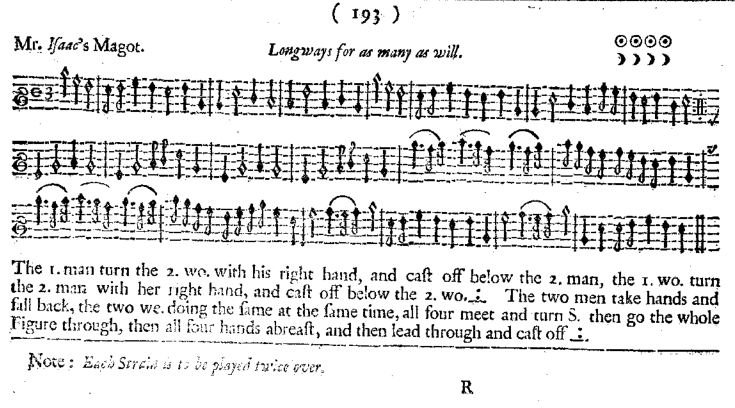
The version I call is very close to Colin Hume's, further justified and slightly tweaked by Dezais, where a version of this dance is entitled Les Folies d'Isac.
Sharp, Shaw and Hume have all agreed that there should be one A and one B despite explicit instructions to the contrary – that looks very much like a misprint and this is confirmed by Dezais.
The challenge with this dance is the rather short amount of time you have for the full figure of 8. Cecil Sharp, not for the first time, rather inexplicably substituted a circular hey instead. Pat Shaw made it a half figure of 8. Colin Hume had the conviction to do what it actually says, which is a whole figure of 8.
Let's look at Dezais' diagrams:
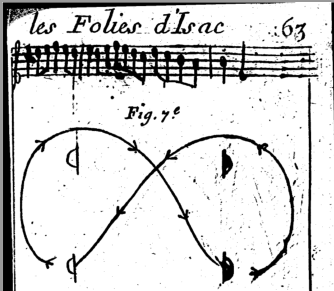
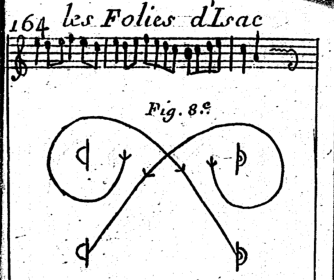
That's pretty conclusively a full figure of 8, finishing in a line of four, in the 4 bars we have available.
Look more closely at the tick marks. They are not arrows by the way, they are meant to represent feet on the floor, so they're actually pointing the other way to the direction you might expect. They mark the passage of time, and throughout most of the rest of the dance there is one per bar. But in the first half there are four for two bars! Some people have just concluded that this was due to a lack of care by Dezais, but I think something more interesting is likely. Added together, you have six tick marks over four bars. If you do a skip change to this, it goes across the music in a pleasing way, and indeed you have six step units in four bars.
Whether historically it was actually a skip change step (known later historically as a chassée step) that was used is another matter – it's probably a bit early for that. But Mr. Isaac was one of the great dancing masters of the age and knew a thing or two about footwork, and to Baroque dancers I'd suggest trying a pas de bourrée step in hemiola rhythm, rather as Barbara Segal has suggested for three-time hornpipes. To modern dancers, a skip change is a lot more accessible, and also makes it easier to cover the distance.
I'd also recommend that, particularly to assist people that aren't able to cover that ground, 2C help, shortening the path by moving at the same time and casting to the end of the line of 4. For this move to be successful usually either 1C has to skip change or 2C has to shorten the path; if both are done it's even more satisfying.
Let's look at Dezais' diagrams just prior to this:
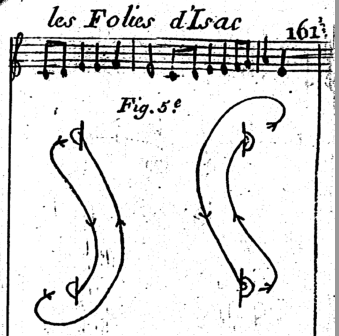
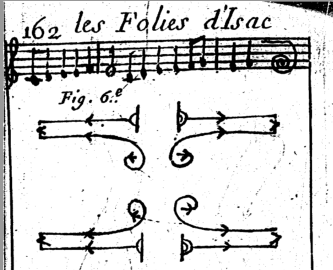
To understand this you need to know Dezais' first part is slightly different and doesn't progress 1C, so we have an extra move to squeeze in here to do that, before falling back, coming forwards, and turning single. This is the other part of the dance were there are extra tick marks, and again there are 6 spread across 4 bars, indicating the faster stepping pattern again. It's a bit manic and if we do what it says in Playford then we don't have to do that.
What I'm interested in is that, rather unusually, it shows the turn single toward your neighbour. Normally when we fall back, we acknowledge our neighbour, then turn single away from them while coming forward. But your focus is to look at your partner when you fall back, turning single toward you neighbour works just fine. And in the context of this dance, turning in that direction sets up the figure of 8 really nicely for 1C, leaving them already moving in the right direction. It also enables 1C to steal a bit of time for the figure of 8 from the previous phrase if needed.
You could argue for two bars back, then two bars forward turning single; or one bar back, one bar forwards, and two bars to turn single on the spot. It's rare there's really enough space for two bars back, one bar back and forwards is more common in other dances, and it gives more time to steal for the figure of 8 if needed. So that's how I call it.
Some people like to finish with a gatepost (2C assisting the 1C cast). That's your call but I don't teach that because it has 2W moving backwards, making it harder to be ready for the next time through.